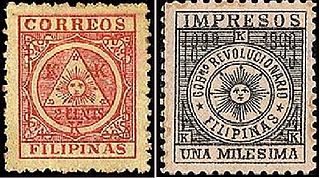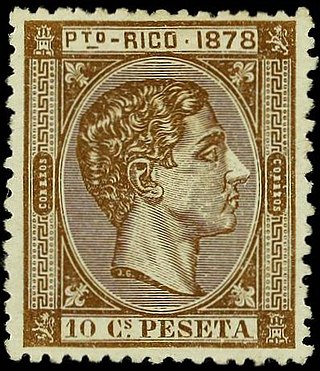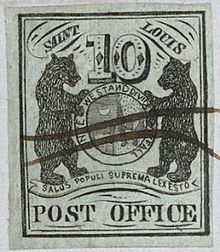
An overprint is an additional layer of text or graphics added to the face of a postage or revenue stamp, postal stationery, banknote or ticket after it has been printed. Post offices most often use overprints for internal administrative purposes such as accounting but they are also employed in public mail. Well-recognized varieties include commemorative overprints which are produced for their public appeal and command significant interest in the field of philately.

A piece of postal stationery is a stationery item, such as a stamped envelope, letter sheet, postal card, lettercard, aerogram or wrapper, with an imprinted stamp or inscription indicating that a specific rate of postage or related service has been prepaid. It does not, however, include any postcard without a pre-printed stamp, and it is different from freepost for preprinted cards issued by businesses. In general, postal stationery is handled similarly to postage stamps; sold from post offices either at the face value of the printed postage or, more likely, with a surcharge to cover the additional cost of the stationery. It can take the form of an official mail issue produced only for the use of government departments.

Indian postal systems for efficient military and governmental communications had developed long before the arrival of Europeans. When the Portuguese, Dutch, French, Danish and British conquered the Marathas who had already defeated the Mughals, their postal systems existed alongside those of many somewhat independent states. The British East India Company gradually annexed the other powers on the sub-continent and brought into existence a British administrative system over most of modern-day India, with a need to establish and maintain both official and commercial mail systems.
This is a partial timeline of significant events in postal history, including dates and events relating to postage stamps.
This is a list of philatelic topics.

This is an overview of the postage stamps and postal history of Australia.

India Post is a government-operated postal system in India, part of the Department of Post under the Ministry of Communications. Generally known as the Post Office, it is the most widely distributed postal system in the world. Warren Hastings had taken initiative under East India Company to start the Postal Service in the country in 1766. It was initially established under the name "Company Mail". It was later modified into a service under the Crown in 1854 by Lord Dalhousie. Dalhousie introduced uniform postage rates and helped to pass the India Post Office Act 1854 which significantly improved upon 1837 Post Office act which had introduced regular post offices in India. It created the position Director General of Post for the whole country.

The Mexican postal system has its roots in the Aztec system of messengers which the Spanish adopted after the Conquest. A postal service was established in 1580, mainly to communicate between the viceroyalty of New Spain with the motherland Spain. During the 18th century, Spain established a formal postal system with regular routes. In 1856, Mexico issued its first adhesive postage stamps, with "district overprints", a unique feature among postal systems worldwide, employed to protect from theft of postage stamps.

This is a survey of the postage stamps and postal history of Cuba.

The postage stamps and postal history of Guam is an overview of the postage stamps and postal history of the United States territory of Guam. Its postal service is linked to those of the Philippines during the Spanish Empire and, since 1898, to the United States of America. A peculiarity is that, for a short period in the 1930s, Guam had a local post service.

Official mail is mail sent from, or by, an authorized department of government, governmental agency or international organization and normally has some indication that it is official; a certifying cachet, return address or other means of identity, indicating its user. In some countries, postage stamps have been issued specifically for official mail.
The Stamp Specialist is the title of a series of books on philatelic research written and edited for the advanced collector of postage stamps.

A specimen stamp is a postage stamp or postal stationery indicium sent to postmasters and postal administrations so that they are able to identify valid stamps and to avoid forgeries. The usual method of invalidating the stamps is either overprinting in ink or perforating the word Specimen across the stamp and where English is not the common language, the words Muestra (Spanish), Monster (Dutch), Muster (German) or Образец have been used instead.

In philately, an imprinted stamp is a stamp printed onto a piece of postal stationery such as a stamped envelope, postal card, letter sheet, letter card, aerogram or wrapper. The printing may be flat upon the surface of the paper, or embossed with a raised relief. An imprinted stamp is also known as unadhesive stamp or indicium.

This is a survey of the postage stamps and postal history of Gibraltar.

Colombia is a country in north-western South America. Colombia is bordered by Venezuela, Brazil, Ecuador, Peru, Panama and the Caribbean Sea and the Pacific Ocean. With a population of over 45 million people, Colombia has the second largest population in South America, after Brazil. The capital is Bogotá.

This is a survey of the postage stamps and postal history of the Philippines.

The postal history of Puerto Rico began around 1518, at least for official mail, when Spain adopted general postal regulations; although the first documentation of Spanish postal regulations specific to the Caribbean was 1794. The first postage stamps were issued 167 years ago for Puerto Rico and Cuba in 1856. Postage stamps just for Puerto Rico followed, and later postal cards and telegraph stamps were issued. United States postal administration began in 1899 and the last stamps specifically for Puerto Rico were issued in 1900. They were superseded by U.S. stamps, which are still used today on the island as it remains a territory serviced by the United States Postal Service (USPS).

Governing authorities in the Philippines have issued a variety of stamps for internal revenue taxes and other fiscal taxes since 1856. Prior to 1856, internal revenues were collected via stamped paper. Revenue stamps for the Philippines were issued by the Spanish East Indies government (1856–1898), the revolutionary government of the First Philippine Republic (1898–1901), the Insular Government of the United States (1901–1935), the government of the Commonwealth of the Philippines, the Philippine Executive Commission (1942–44) and the Republic of the Philippines (1946–present).

















